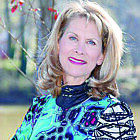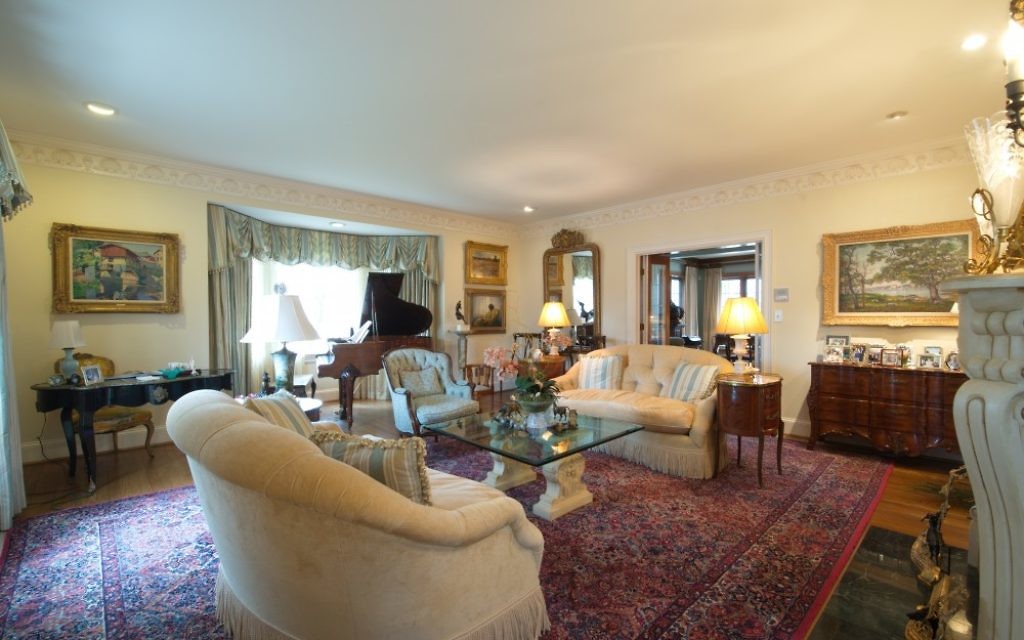Buckhead Manse Plays Part of Parisian Salon
Dr. Albert Amato and Maria Guarisco-Amato collect houses as others collect candlesticks or coffee mugs: frequently and gloriously. A blended family, they combined and acquired homes in Asheville, Lake Rabun, Naples and Sandy Springs, plus a farmhouse in Ellijay.
Maria, who owns the Madison Gallery on Miami Circle, inherited (with her siblings) her father’s collection of 18th-to-20th-century marine and genre art.
Their 7,500-square-foot Buckhead home and pool house let the art do the talking. Maria certainly has the eye and glides along as a lithe dancer describing the pieces in perfect French.
Get The AJT Newsletter by email and never miss our top stories Free Sign Up
—
Jaffe: Why all these homes? Are they all different?
Maria: I don’t think we NEED any more homes, but it’s wonderful that I have more space to see and show art. Each home has a different style, but the art is basically the same period. I do not buy art to match a house. It’s what I love and collect that counts.

Jaffe: Albert, how do you fit in to the design phenomenon?
Albert: Charmingly, we were introduced to each other by Maria’s interior designer, Joy McClain. I collect fine sterling silver pieces, watches, coins and guns. Some of my prizes work well with Maria’s paintings: This silver champagne chiller and tea service from 1857 is comfortable in the dining room with her traditional furniture. The silver animals from South Africa are individually named after real creatures. They reside under Yon’s French 19th-century painting “Afternoon at the Beach.”
Jaffe: Your living room reminds me of a parlor in the traditional sense of a Parisian hotel particulier.
Maria: It’s a mixture. I bought this Napoleon III older-style desk in New York. The 19th-century painting by Paul Madeline (1863-1920), “Le Sechage des Drapes,” is post-impressionistic. The piano is a Sohmer, similar to the one owned by Calvin Coolidge and Irving Berlin. This fabulous Connecticut tree painting is by Reynolds Beal.
Albert: What’s also unique is this bronze collection of prehistoric horses, “Mares at Play,” based on cave drawings from the Dordogne Valley in France by artist Star York.
Maria: Over the fireplace, note the scarlet hair tones in the Henner painting (19th-century Paris). It has a tonalist, soft quality. The only pastel chalk in here is Barbizon’s L’Hermitte.
Jaffe: Your French accent sounds authentic.
Maria: My father was a Louisiana pioneer in oil and gas. I was a French literature major. Our family spent many years traveling to Europe and New York, collecting 1700s to 20th-century marine and genre art. I’ve been to Europe many times since then to buy art for the gallery and myself. I started collected in the ’70s. My first painting was by a Dutchman, Pieters.
Jaffe: Albert, you have strong Sephardic roots. Any influences here?
Albert: Actually, my 95-year-old mother is an amateur artist. But the most meaningful tradition we have with her is going as a family to the Or VeShalom kitchen to make burekas. My parents inspired me to become a collector and appreciate art at a young age.
Jaffe: There are a plethora of wave and beach themes in your large paintings.
Maria: I am fascinated by how light hits the water, moves and looks different at different parts of the day. The big “Sea” in the breakfast room is by Kenzler. In the library is a John Hilverdink (19th century) of the light accenting the crashing waves.
Albert: Also, the library displays a large sterling trophy cup. Silver that is hammered by hand with elaborate details is my favorite. My friend Mark Antebi (Atlanta Silver), an expert in silver, steered me to quality collectible antique pieces. Also in here are some works from Cuba. We visited the art school in Havana and were surprised to find that Castro lets them thrive. Primarily modern and graphic art, all well done.
Jaffe: The foyer sets the tone of the magnificence inside.
Maria: I like this charming painting by Simon of a Brittany village in gouache, which is milk-based watercolor. When I was rearing children, I often collected that theme like this “Child Reading” (William Owen) with the background landscape like the old-style 18th-century masters. This sculpture was my father’s by a well-known American, Harriet Frishmuth. As a contrast, California impressionist Nyholm crafted this coastal scene (19th century).
Jaffe: The front entrance geisha painting is so striking.

Maria: Funny story there. It’s by an Englishman, Stuart Hobkin (19th century), “Blue Kimona.” The British wanted to show that they were well traveled and glamorized exotic women. It was a fad of that time.
Jaffe: The pool house beckons with stately charm.
Maria: We added it and entertain out here. The maritime art is thematic. This impressionistic painting of the Amalfi coast is rather loosely done. Marengo did this red-and-white boat painting. We had these camplike chairs recovered in a casual fish pattern.
Albert: The air flow here is pleasant when we open all the French doors. We like to eat and entertain here.
Jaffe: It’s rather formal how your master has its own foyer apart from the main mezzanine.
Albert: This is a house from the ’40s that has expanded. This area is based around Maria’s mother’s hutch with art on both sides.
Maria: In the master, see the pale mint-green Italian four-poster bed; I had to have it. Saw it in a window in ADAC. The two most important paintings in here are “The Dawn of Hope” over the fireplace (Gerhartz), which is an angel expressing hope in face of a sad time, and Hubert’s “First Communion With Nuns.” It looks like a wedding scene, but it’s not.

Jaffe: Hard to have nuns in a wedding procession. As a collector, if you could wake up tomorrow and have one more piece, what would it be?
Maria: Hmm. I’ve always wanted a Bouguereau, but it looks like I missed the boat on that.
Jaffe: Well, with this maritime art, you haven’t missed many boats.
Photos by Duane Stork






comments